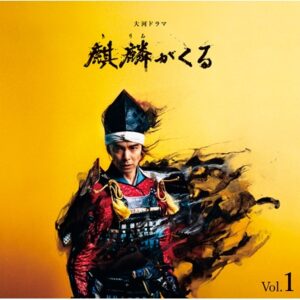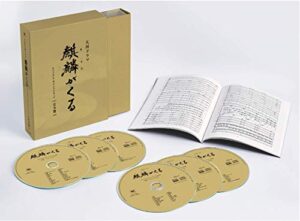麒麟〜聖獣〜 / The Kirin 収録OST: Vol.1 / The Best / 完全盤
物語を通じて、光秀は普遍的に続く平和な麒麟がくる世という理念が心にありました。「麒麟がくる」という考えは、様々な人物を通じて何度も何度も登場し、主人公である光秀の中に強く存在していました。狡猾で好戦的な斎藤道三ですらも、光秀に大きな国を作るよう説く時、麒麟を暗に語ります。
麒麟のような聖獣は諸外国の文化にも存在しますが、この物語の麒麟は、神秘的で強さを秘めた、太平の世にだけ姿を現す生き物です。麒麟が平和をもたらすのではなく、麒麟の到来が戦争の終わりと世の調和の布告なのです。
音楽の構想として、麒麟の曲には神秘性と力を纏わせたいと考えました。神秘性を表現するために、朧(おぼろ)を感じることができる響きを模索しました — リズム的には浮遊感と和声が異なるタイミングで交互に動き続けるもの(合唱や弦など)そして楽器は特定の文化や民族性に属さないもの。その結果、前奏箇所では、揺らめく背景の表現として、ハープ、琴、シンバロン(東欧の打楽器)、ダルシマー、ベル、女性合唱が使用されています。弦はスルタスト(指板に寄せた弓を柔らかく繊細に演奏する技法)とセンツァ・ヴィブラート(ヴィブラートがない奏法)により、硝子のような質感と声のような表現を目指し、ビオラはポコ・ヴィブラート(ヴィブラートを少しいれる奏法)により前衛的に存在感を出して、中米笛のケーナを重ねました。これらのアジア、ヨーロッパ、アメリカ大陸、そして演奏技法による独特な響き(弦のスルタストなど)により、あえて伝統的なオーケストラの響き、そして日本的な響きから遠ざけるようとしました。音楽から地域を感じられる要素を朧げにすることで、麒麟が遠い場所、もしかするとこの世ではない場所から訪れる存在であることを表現しています。
最後の2’21箇所から、ケーナが麒麟のテーマを奏でます。背景は朦朧と柔らかく浮遊させることで、優しく神秘的な麒麟の存在を表現しています。その後、弦と他の木管楽器が、麒麟のテーマをチェロと共に奏でます。
3’23箇所から、麒麟の力強さが表現されています。優しく揺らぐよう演奏する弦に、金管が徐々に筋力を与え、4’00箇所からは壮厳で力強い麒麟の存在感が表現されています。ここで表現されている麒麟は、奥ゆかしい生き物ではありません。神々しく平和を布告する麒麟の存在であり、到来の様子が、合唱、金管、打楽器、そして木管と弦によって表現されています。
この曲が完成するにあたり、高い芸術性と感受性を持つ優秀な指揮者と世界クラスのオーケストラは欠かせませんでした。マエストロ広上淳一とNHK交響楽団は、高い芸術性と抑揚に満ちた表現力から、曲の最後の力強いトゥッティまで、ダイナマイトのよう(爆発的)に奏で、私の最も好きな収録となりました。0’50箇所から、私が好きなビオラの二重奏が始まります。ここは技術的に難易度よりも高い表現性による美しい演奏が求められる箇所であり、とても魔法的です。そして5’00箇所から、オーケストラにトランペットが極めて意義深く力強い演奏が加わり、聖獣麒麟、そしてこの大河ドラマにおける麒麟の重要性が表現されています。
Throughout the story, Mitsuhide is inspired by the idea of universal, lasting peace, which would allow the Kirin to come. The idea of “Kirin Ga Kuru” is mentioned over and over again, by many different characters, and it is the central motivation for Mitsuhide, our protagonist. Even the crafty, warlike Dosan Saito indirectly alludes to it when he tells Mitsuhide to make a “big country.”
There are many versions of the Kirin, in many cultures; the idea of Kirin for our story is that of a magic, powerful creature, that can come only when there is peace in the land. The Kirin does not directly bring about peace, but its arrival heralds the end of war, and a level of harmony.
Musically, I wanted the Kirin’s music to embody both magic and power. For the magical side, I sought sounds that were somewhat indefinite – rhythmically somewhat “floaty,” harmonies moving at different times in different sections (choir and strings, for example), and instruments that don’t necessarily fit neatly into one culture or musical tradition. So, for the opening, there is a shimmering background, using harp, koto, cimbalom (an Eastern European instrument that is struck), dulcimers, bells, and women’s choir. The strings are playing sul tasto, senza vibrato, which gives a glassy, choir-like sound as well, with violas playing poco vibrato providing the first section’s feel, accompanied by a central American quena flute. As you can see, there are instruments from Asia, Europe, the Americas, and effects (like the sul tasto in the strings) that intentionally locate the ear away from a completely traditional orchestral sound, or even a Japanese sound; the Kirin is from somewhere else, not necessarily of this world, so I wanted the music to be geographically ambiguous.
At last, at about 2’21, the quena flute begins to play the main Kirin theme, solo. The background remains floating, indeterminate, and gentle; this is the soft, magical side of the Kirin. Then the strings, other woodwinds take up a reworked version of the melody, accompanied by the cellos.
At 3’23, we start to hear the more powerful side of the Kirin. The brass begins to put muscle behind the floaty, gentle strings, building little by little to about 4’00 when we hear the power and majesty of the Kirin. This no longer is the shy, tentative, shimmering beast; the Kirin is now a glorious herald of peace, with choir, brass, and percussion joining the winds and strings, announcing the great arrival.
This track would have been impossible to pull off without the artistry and sensitivity of a fine conductor and a world-class orchestra. Maestro Junichi Hirokami and the NHK orchestra were dynamite — from artistic expressiveness to the powerful tutti at the end, this is one of my favourite recordings. There is a particularly challenging duet for two solo violas that starts at about 0’50” that I love. It is not technically at all difficult, but the expressiveness and beauty of the playing is magic. Then, near the five-minute mark, the trumpets join the full orchestra for an enormously meaningful, powerful expression of the importance of the Kirin, both in myth and to the Taiga Drama.
♫ ダウンロード&ストリーミング配信
「麒麟〜聖獣〜 / The Kirin」
from サウンドトラック Vol.1
※ NEXT COMPOSER NOTES
「美濃の里 / Mino, My Home」
アルバム
NHK大河ドラマ「麒麟がくる 」オリジナル・サウンドトラック Vol.1
[発売日] : 2020.01.29
¥3,000+ 税
ソニー・ミュージックレーベルズ / SICX-30083
アルバム
NHK大河ドラマ「麒麟がくる」オリジナル・サウンドトラック The Best
[発売日] : 2021.02.24
¥3,200+ 税
ソニー・ミュージックレーベルズ / SICX-10010
アルバム
NHK大河ドラマ「麒麟がくる」オリジナル・サウンドトラック 完全盤
[発売日] : 2021.02.24
¥15,000+ 税
ソニー・ミュージックレーベルズ / SICX-30090 ~ SICX-30095



